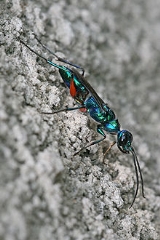
Spheciformes
Encyclopedia
The Spheciformes is a paraphyletic assemblage of insect
families
which collectively comprise the "sphecoid wasps"; these are all the members of the superfamily Apoidea
which are not bee
s, and in older classifications were called the "Sphecoidea". The group is paraphyletic because the bees are believed to have arisen from a subgroup within the family Crabronidae
, thus Spheciformes does not include all of the descendants of its common ancestor.
Insect
Insects are a class of living creatures within the arthropods that have a chitinous exoskeleton, a three-part body , three pairs of jointed legs, compound eyes, and two antennae...
families
Family (biology)
In biological classification, family is* a taxonomic rank. Other well-known ranks are life, domain, kingdom, phylum, class, order, genus, and species, with family fitting between order and genus. As for the other well-known ranks, there is the option of an immediately lower rank, indicated by the...
which collectively comprise the "sphecoid wasps"; these are all the members of the superfamily Apoidea
Apoidea
The superfamily Apoidea is a major group within the Hymenoptera, which includes two traditionally-recognized lineages, the "sphecoid" wasps, and the bees, who appear to be their descendants.- Nomenclature :...
which are not bee
Bee
Bees are flying insects closely related to wasps and ants, and are known for their role in pollination and for producing honey and beeswax. Bees are a monophyletic lineage within the superfamily Apoidea, presently classified by the unranked taxon name Anthophila...
s, and in older classifications were called the "Sphecoidea". The group is paraphyletic because the bees are believed to have arisen from a subgroup within the family Crabronidae
Crabronidae
Crabronidae is a large family of wasps, that includes nearly all of the species formerly comprising the now-defunct superfamily Sphecoidea. It collectively includes well over 200 genera, containing well over 9000 species. Crabronids were originally a part of Sphecidae, but the latter name is now...
, thus Spheciformes does not include all of the descendants of its common ancestor.

